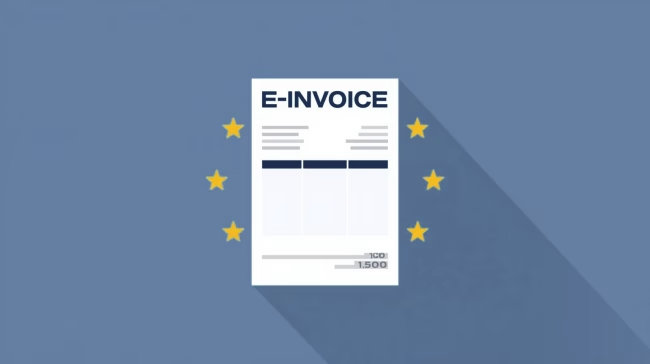From 1 January 2025, an important change for companies in the B2B sector will come into force: the mandatory introduction of e-invoicing. This step towards digital transformation not only offers more efficient processing without paperwork. Electronic invoicing also makes an important contribution to resource conservation and environmental friendliness. The use of standardised formats such as XRechnung and ZUGFeRDthat meet European standards, companies can automate and digitalise their invoicing processes.
Implementation of the e-bill
To facilitate the introduction of electronic invoicing, it is essential to update the customer master data. The email addresses required for sending electronic invoices should be recorded. The elimination of the need for prior consent for electronic invoicing in the B2B sector significantly simplifies the transition to digitalised invoicing processes.
Increasing efficiency with the e-bill
It is recommended that all customer relationships be converted to the use of e-invoices. The hybrid ZUGFeRD format has the advantage that it contains both machine-readable data and a human-readable PDF file. Adapting the processes for incoming and outgoing invoices and utilising automation options are further steps to fully exploit the benefits of electronic invoicing.
The Growth Opportunities Act and the legal requirements
The Growth Opportunities Act, which was confirmed by the Federal Council on 22 March 2024, sets new standards for economic development through technological and organisational innovations. Part of this law is the obligation for German companies to be able to receive electronic invoices from 2025, whereby the previous prioritisation of paper invoices will no longer apply.
What transitional regulations apply to the e-bill?
The following transitional arrangements are intended to enable companies to gradually adapt to the digital requirements and carry out the necessary system updates to ensure a smooth transition.
The following regulations apply to invoicing until the end of 2026:
- Companies may continue to issue paper invoices for sales from 2025 and 2026.
- Electronically transmitted invoices that do not comply with the latest format can still be used, provided the recipient agrees.
For the period until the end of 2027, the regulations will be extended under certain conditions:
Companies that recorded a maximum turnover of 800,000 euros in the previous year may continue to apply the regulations from 2026. If a company exceeds this turnover limit in 2026, it is obliged to only use electronic invoices.
From 2028, the following requirements will be binding for the e-bill:
- Full compliance with the new regulations on electronic invoicing will be mandatory.
- From 1 January 2025, companies must be able to receive invoices in accordance with the EN 16931 standard. This means that from this date, there will no longer be any entitlement to receive invoices in alternative formats such as PDF or paper.

Guidelines for archiving electronic invoices
Electronic invoices must be processed and stored electronically without media discontinuity. It is not permitted to print out electronic invoices and archive them on paper. As electronic invoices, including XRechnungen and the ZUGFeRD format, are legally equivalent to paper invoices, they are subject to a retention period of ten years.
Document management systems, such as CKS-DMSoffer support for the legally compliant archiving of such documents. They ensure that invoices remain unalterable throughout the entire retention period.
Continuation of the EDI procedure
Electronic Data Interchange (EDI), a technology for the electronic transmission of business documents, was introduced in the 1960s. Ed Guilbert originally developed a method of electronic communication specifically for the US Army's supply chains. This approach made it possible to exchange business documents in a standardised format from computer to computer,
Companies can continue to use the Electronic Data Interchange (EDI)a system for the electronic exchange of business documents. However, it is important that the processed information is prepared in such a way that it complies with the standards of CEN standard EN 16931.

The PEPPOL integration in SAP Business One provides companies with an efficient platform for seamlessly processing electronic documents.
Comparison of ZUGFeRD and XRechnung as a format for e-invoicing
ZUGFeRD version 2.1.1 corresponds to XRechnung in terms of content and therefore fulfils the requirements of the German administration for e-invoicing. Nevertheless, there are significant differences between the two formats:
File format and extension:
ZUGFeRD uses a hybrid data format that consists of a PDF/A-3 part, which is readable by the user, and an embedded, machine-readable XML file. This format has a .pdf extension and contains an attachment called zugferd-invoice.xml. In contrast, the XRechnung is a pure XML file with the extension .xml, which clearly separates the file formats.
Syntax:
There are also differences in terms of syntax. According to the EU standard, the XML schemas Universal Business Language (UBL) and Cross Industry Invoice (CII) are permitted for electronic invoices. While XRechnung can be implemented in both formats, ZUGFeRD only supports the CII standard.
Target groups:
XRechnung was developed specifically for invoicing with German authorities (B2G), while ZUGFeRD was primarily designed for business-to-business (B2B) invoice exchange. The use of ZUGFeRD in the B2B area is voluntary.
Nonconformity and extensions:
ZUGFeRD 2.1.1 has been adapted to XRechnung in order to fulfil all the requirements of EN 16931. At the same time, XRechnung extends the EU standard by 21 additional national business rules that are specifically aimed at German legal requirements for electronic invoicing.
These differences illustrate that despite the basic similarities between ZUGFeRD 2.1.1 and XRechnung, the specific use cases and technical implementations can vary depending on the user group and legal requirements for e-invoicing.
Instructions for creating an XInvoice in SAP Business One
In this guide, you will learn step by step how to create an XRechnung in the German localisation of SAP Business One and SAP Business One Version for HANA create. The following instructions cover the necessary settings and steps required to correctly create and send an XRechnung:
- Activation of the Electronic Document ServiceThis is the first step towards enabling electronic documents within SAP Business One.
- Definition of an electronic document number seriesHere you define the number ranges that are then used for electronic invoices.
- Import of Peppol-relevant data from MS ExcelThis step is crucial to ensure that all relevant information for the Peppol network is correctly fed into the system.
- Establishment of a generic scenario for PeppolThis allows the system to be customised to the specific requirements of the Peppol network.
- Use of the Import Wizard for electronic documentsThis tool allows you to efficiently import electronic documents into SAP Business One.
- Maintenance of XRechnung-relevant master dataEnsure that all master data required for creating an XRechnung is stored correctly.
- Generation and export of the XRechnungFinally, we describe how to generate the XRechnung and prepare it for dispatch.
This guide is a detailed support to navigate the complexity of XInvoice creation. It is intended to help ensure that invoices from SAP Business One comply with legal requirements.
Preparation and outlook
It is essential that companies adapt their invoicing processes at an early stage. The aim is to be able to receive and process electronic invoices smoothly from the start date. Software solutions such as SAP Business One already support the necessary formats and make the changeover much easier. The planned introduction of e-billing is an important step towards a comprehensive digital transformation of the financial sector in Germany. This will enable companies to operate more competitively through more efficient processes.
These new regulations should not only increase efficiency, but also contribute to transparency and the fight against VAT fraud. The EU has already laid the foundations for standardised electronic invoicing with Directive 2014/55/EU. This is now being implemented at national level. This promotes the harmonisation and integration of digital processes in the European single market.

Die E-Invoicing-Vorschriften in Europa

E-bill 2025 FAQs

Preparation for the introduction of CKS.EINVOICE

E-invoicing - The flexible EN 16931 standard

E-Invoice master data and settings in SAP Business One

Archiving of e-invoices

International e-invoices: differences and global developments

MariProject / Tool for e-invoicing

cks.eINVOICE -Addon for XRechnung & ZUGFeRD




